
After several weeks on the road recruiting, Nebraska head coach Matt Rhule is ready to get back around his team.
“I’m just really excited to be back in the building and around the guys,” Rhule said Wednesday. “I did not get into college football and college coaching to be a great recruiter; I got in it to coach the guys day by day. Recruiting’s something you have to do to get the right guys there.”
The recruiting grind hardly ever stops for college coaches, though the completion of this year’s cycle marked a job well done by the Nebraska staff. The Huskers’ 2024 recruiting class is ranked as high as No. 16 nationally by Rivals, and many of its most promising members have been on campus for weeks already. Let’s drop into coverage:
1. Wrapping up the 2024 cycle
National Signing Day on Wednesday marked the end of the 2024 recruiting cycle, and it’s worth looking at the timeline Nebraska followed to build its class. Roger Gradney was NU’s first pledge last February, followed by six scholarship additions across April and May. Over a dozen recruits joined the class in June and July following a busy stretch of camps, while NU’s in-season efforts were quiet for the most part as a few players trickled into the class.
People are also reading…
A final flurry of additions in December came next, followed by Nebraska’s lone scholarship addition in February, defensive end Keona Wilhite.
“He’s (Wilhite) exactly the type of person we’re looking for. On the football field, he’s big, strong, athletic and physical; he’s going to be a huge man with great athleticism,” Rhule said.
Nebraska coaches treat recruiting as a full-time gig during those busy stretches. As NU moves on to its 2025 class, it’s likely that once again, the stretch between April and June will include the bulk of the program’s future commitments.
2. Impactful 2024 class
Nebraska’s 2024 class is highly talented overall, and the versatility displayed by many of its members will be a storyline to follow in the coming seasons. As a mini list inside this Cover Five, here are five recruits who can be expected to impact the long-term future of Nebraska football.
Nebraska head coach Matt Rhule motions to his players during the Purdue game on Oct. 28, 2023, at Memorial Stadium.
KENNETH FERRIERA, Journal Star file photo
First up is quarterback Dylan Raiola. No player can truly change the trajectory of a program more than a quarterback, and Raiola will have every opportunity to reach his full potential. Quarterbacks coach Glenn Thomas will work with him every step of the way, and it’s also likely that Thomas and Marcus Satterfield will rework the NU offense to fit Raiola’s strengths.
That is, if the freshman becomes the team’s starter in the first place. If Raiola hadn’t been in this class, Daniel Kaelin would’ve been the quarterback of the future Husker fans closely followed for months. Instead, the quarterback competition across the spring and fall could be one to remember.
Next up is a historically good prospect from within the state’s borders, tight end Carter Nelson. A do-it-all offensive weapon at the eight-man level with Ainsworth, Nelson looked right at home physically and athletically in the two high school all-star games he took part in this winter. Pass-catching tight ends of Nelson’s caliber don’t come about often.
On the defensive side of the ball, Jack linebacker Willis McGahee IV is going to strike fear into opposing offensive linemen and quarterbacks for years to come. McGahee’s father was an NFL running back, and he has all the potential needed to be a professional player in the future as well. McGahee’s pure strength, explosiveness and pass-rushing moves make him difficult to slow down.
In the secondary, cornerback Mario Buford fits Nebraska’s defensive philosophy like a glove. Buford’s long arms and physical coverage style make him a perfect fit for one-on-one coverage, something NU’s starting cornerbacks are asked to do often. With a nose for the football and the ability to cover ground quickly, Buford is a future game-changer.
And among a talented group of offensive linemen, Grant Brix stands out as a technically sound, physically gifted offensive tackle prospect. Preston Taumua and Gibson Pyle are two other potential future starters, but Brix’s athleticism is what lifts him above the rest. Few linemen possess the power needed to drive opponents backward and the quickness required to maneuver pass rushers around the quarterback — and Brix has that elite combination.
3. Don’t doubt Dowdell
A position battle worth keeping an eye on this spring is at running back, where sophomore transfer Dante Dowdell will have the opportunity to make a good first impression. Two of NU’s top returning options at the position, senior Rahmir Johnson and junior Gabe Ervin Jr., will be limited in the spring as they continue rehabbing from fall surgeries.
Sophomore Emmett Johnson, who impressed late in the 2023 season, and redshirt freshman Kwinten Ives are the other scholarship backs in the room who’ll compete with Dowdell. The Oregon transfer can separate himself with a physical running style that should make him a good fit for Nebraska’s offensive plans.
Contrasted with Rahmir and Emmett Johnson, players who hover around 185-190 pounds, Dowdell’s 6-foot-2, 215-pound frame is what immediately stands out to his head coach.
“The fact that he is a big back, with our style of football and playing in the Big Ten, we don’t want every back to look the same,” Rhule said of NU’s decision to add Dowdell to the roster. “I want a Rahmir next to a Gabe, (and) I want an Emmett next to a Dante.”
4. Future of college athletics
The writing is on the wall that more dramatic changes at the national level will soon impact the future of Nebraska football.
In December, NCAA President Charlie Baker publicly shared a proposal that would create a new tier of collegiate athletics where schools would be allowed to directly compensate athletes. Such a move would eliminate some of the existing headaches around the NCAA’s NIL rules, and it’d also pave the way for college football’s elite programs to continue making the most of increasing financial revenues.
Such a change to the status quo would seemingly be several years away, but recent news from this week shows it could happen sooner than you’d think.
After the Dartmouth men’s basketball team petitioned for their right to form a union, a regional director from the National Labor Relations Board ruled on Monday that the players are employees of their school and thus may join a union.
The decision is a reversal of previous precedent the NLRB established in 2015, when Northwestern football players also sued claiming to be employees of their respective university. Part of the justification at the time was that such a change “would not promote labor stability” according to the NLRB ruling.
But nearly a decade later with ever-increasing revenues flowing into many collegiate programs, the Dartmouth ruling indicates that the NCAA’s legal standing could be changing.
“Because Dartmouth has the right to control the work performed by the men’s varsity basketball team and because the players perform that work in exchange for compensation, the petitioned-for basketball players are employees within the meaning of the Act,” NLRB official Laura Sacks wrote within the ruling.
Regardless of the success of any future Dartmouth men’s basketball team union, the key takeaway is that the courts could define athletes as employees of their school — legally requiring direct compensation for their participation on sporting teams.
Dartmouth is expected to appeal the ruling, meaning it could take over a year for the case to snake through the legal system. It’s highly likely the Supreme Court will eventually be needed to establish a binding legal precedent just as it did in 2021 when it unanimously voted 9-0 for student-athletes being able to financially benefit from their name, image and likeness.
Two days after the Dartmouth ruling, Big Ten and SEC university presidents came together to form a joint advisory committee that will help the college football’s two mega-conferences stay strategically aligned.
A mere coincidence? I think not.

Nebraska’s Gabe Ervin runs in a touchdown during last year’s Spring Game. This year, the game will be held on April 27.
KENNETH FERRIERA, Journal Star file photo
5. Nebraska football’s spring schedule
The Nebraska football team is currently going through its offseason workouts. These days include high-intensity workout sessions, competition and team-building activities that take place both within NU’s football facilities and outside of it.
Nebraska will wait to begin practicing until after spring break, which runs from March 10-17.
Based on the timeline for the 2024 spring game, the Huskers should begin spring practice around March 24-25. Due to NCAA guidelines around spring team activities, 15 practices can be spread over a 34-day window. With limitations on the number of days teams can spend in full pads and only three scrimmages allowed over that period, the Red-White Game on April 27 marks the final practice day and scrimmage of the spring.
Photos: Nebraska women’s basketball hosts Iowa, Feb. 11

A view inside Pinnacle Bank Arena during the first half of the game against Iowa on Sunday, Feb. 11, 2024.
KATY COWELL Journal Star

Nebraska’s Jessica Petrie (12) wears a pink bow in her hair during the game against Iowa on Sunday, Feb. 11, 2024, at Pinnacle Bank Arena.
KATY COWELL Journal Star

Nebraska’s mascot Lil’ Red dances during the pregame announcements before the game against Iowa on Sunday, Feb. 11, 2024, at Pinnacle Bank Arena.
KATY COWELL Journal Star

Nebraska’s Jaz Shelley, right, hugs Nebraska assistant coach Jessica Keller after the game against Iowa on Sunday, Feb. 11, 2024, at Pinnacle Bank Arena.
KATY COWELL Journal Star

Nebraska’s Jaz Shelley (1) smiles after taking the lead over Iowa during the second half of the game on Sunday, Feb. 11, 2024, at Pinnacle Bank Arena.
KATY COWELL Journal Star

Nebraska’s Jaz Shelley (1) passes the ball while guarded by Iowa’s Gabbie Marshall (24) on Sunday at Pinnacle Bank Arena.
KATY COWELL, Journal Star

Iowa’s Caitlin Clark (22) speaks to official Jesse Dickerson during the game against Nebraska on Sunday at Pinnacle Bank Arena.
KATY COWELL, Journal Star

Nebraska’s Darian White (0) dribbles behind her back while guarded by Iowa’s Kate Martin (20) during the second half of the game on Sunday, Feb. 11, 2024, at Pinnacle Bank Arena.
KATY COWELL Journal Star

Nebraska’s Annika Stewart (21) reacts to a play during the second half of the game against Iowa on Sunday, Feb. 11, 2024, at Pinnacle Bank Arena.
KATY COWELL Journal Star

Nebraska’s Jaz Shelley (1) celebrates by waving her hand in front of her face after making a 3-pointer during the second half of the game against Iowa on Sunday, Feb. 11, 2024, at Pinnacle Bank Arena.
KATY COWELL Journal Star

Nebraska’s Alexis Markowski (40) grabs a loose ball before Iowa’s Taylor McCabe (2) during the second half of the game on Sunday, Feb. 11, 2024, at Pinnacle Bank Arena.
KATY COWELL Journal Star

Nebraska head coach Amy Williams speaks to her team during a timeout in the second half of the game on Sunday, Feb. 11, 2024, at Pinnacle Bank Arena.
KATY COWELL Journal Star

Nebraska head coach Amy Williams celebrates during the second half of the game against Iowa on Sunday, Feb. 11, 2024, at Pinnacle Bank Arena.
KATY COWELL Journal Star

Nebraska head coach Amy Williams reacts to a foul called against Nebraska during the second half of the game against Iowa on Sunday, Feb. 11, 2024, at Pinnacle Bank Arena.
KATY COWELL Journal Star

Iowa’s Caitlin Clark (22) speaks to her team during a timeout in the first half of the game against Nebraska on Sunday, Feb. 11, 2024, at Pinnacle Bank Arena.
KATY COWELL Journal Star

Iowa head coach Lisa Bluder reacts to a call during the first half of the game on Sunday at Pinnacle Bank Arena.
KATY COWELL, Journal Star

Nebraska assistant coaches Tandem Mays, left, Jessica Keller and director of operations Amanda Hart react to a call against Nebraska during the first half of the game on Sunday, Feb. 11, 2024, at Pinnacle Bank Arena.
KATY COWELL Journal Star

Iowa’s Caitlin Clark (22) attempts a 3-pointer over Nebraska’s Jaz Shelley (1) with nine seconds left in the second half of the game on Sunday, Feb. 11, 2024, at Pinnacle Bank Arena.
KATY COWELL Journal Star

Nebraska’s Jaz Shelley (1) shoots a 3-pointer during the second half of the game on Sunday, Feb. 11, 2024, at Pinnacle Bank Arena.
KATY COWELL Journal Star

Nebraska’s Natalie Potts (22) and Nebraska’s Kendall Moriarty (15) chase after a loose ball during the second half of the game against Iowa on Sunday, Feb. 11, 2024, at Pinnacle Bank Arena.
KATY COWELL Journal Star

Nebraska’s Alexis Markowski (40) goes up for a layup against Iowa’s Hannah Stuelke (45) on Sunday at Pinnacle Bank Arena.
KATY COWELL, Journal Star

Nebraska’s Jaz Shelley (1) attempts a 3-pointer over Iowa’s Gabbie Marshall (24) during the second half of the game on Sunday, Feb. 11, 2024, at Pinnacle Bank Arena.
KATY COWELL Journal Star

Iowa’s Caitlin Clark (22) reacts to a turnover called against Iowa during the second half of the game on Sunday, Feb. 11, 2024, at Pinnacle Bank Arena.
KATY COWELL Journal Star

Nebraska’s Logan Nissley (2) shoots a 3-pointer during the second half of the game against Iowa on Sunday, Feb. 11, 2024, at Pinnacle Bank Arena.
KATY COWELL Journal Star

Nebraska’s Maddie Krull (42) attempts a 3-pointer during the second half of the game against Iowa on Sunday, Feb. 11, 2024, at Pinnacle Bank Arena.
KATY COWELL Journal Star

Nebraska’s Alexis Markowski (40) celebrates a 3-pointer with her team during the second half of the game on Sunday, Feb. 11, 2024, at Pinnacle Bank Arena.
KATY COWELL Journal Star

A fan reacts to a foul called on Nebraska during the game against Iowa on Sunday, Feb. 11, 2024, at Pinnacle Bank Arena.
KATY COWELL Journal Star

Iowa’s Caitlin Clark (22) reacts to missing a 3-pointer during first half of the game on Sunday, Feb. 11, 2024, at Pinnacle Bank Arena.
KATY COWELL Journal Star

Nebraska celebrates after winning the game against Iowa on Sunday at Pinnacle Bank Arena. Nebraska won 82-79.
KATY COWELL Journal Star

Nebraska’s Natalie Potts (22) celebrates with the crowd after winning over Iowa on Sunday, Feb. 11, 2024, at Pinnacle Bank Arena. Nebraska won 82-79.
KATY COWELL Journal Star

Nebraska head coach Amy Williams pumps her fists in celebration after winning the game against Iowa on Sunday, Feb. 11, 2024, at Pinnacle Bank Arena.
KATY COWELL Journal Star

Nebraska’s Kendall Coley, center, cries while celebrating with her team after winning over Iowa on Sunday, Feb. 11, 2024, at Pinnacle Bank Arena. Nebraska won 82-79.
KATY COWELL Journal Star

Nebraska celebrates after winning the game against Iowa on Sunday, Feb. 11, 2024, at Pinnacle Bank Arena. Nebraska won 82-79.
KATY COWELL Journal Star

Nebraska’s Jaz Shelley (1) celebrates a 3-pointer during the second half of the game against Iowa on Sunday, Feb. 11, 2024, at Pinnacle Bank Arena.
KATY COWELL Journal Star

Nebraska’s Natalie Potts (22) and Iowa’s Sydney Affolter (3) fight for a loose ball during the game on Sunday, Feb. 11, 2024, at Pinnacle Bank Arena.
KATY COWELL Journal Star

Nebraska’s bench cheers during the game against Iowa on Sunday, Feb. 11, 2024, at Pinnacle Bank Arena.
KATY COWELL Journal Star

Nebraska’s Kendall Moriarty (15) hands the ball off to Nebraska’s Jaz Shelley (1) during the game against Iowa on Sunday, Feb. 11, 2024, at Pinnacle Bank Arena.
KATY COWELL Journal Star

Fans cheer for a Nebraska’s Jaz Shelley 3-pointer during the game against Iowa on Sunday, Feb. 11, 2024, at Pinnacle Bank Arena.
KATY COWELL Journal Star

Nebraska’s Jessica Petrie (12) shoots the ball over Iowa’s Hannah Stuelke (45) during the game on Sunday, Feb. 11, 2024, at Pinnacle Bank Arena.
KATY COWELL Journal Star

A view of Pinnacle Bank Arena during the game between Nebraska and Iowa on Sunday, Feb. 11, 2024.
KATY COWELL Journal Star

Nebraska’s Darian White (0) goes up for a shot during the game against Iowa on Sunday, Feb. 11, 2024, at Pinnacle Bank Arena.
KATY COWELL Journal Star

Nebraska’s Kendall Coley (32) shoots the ball over Iowa’s Sydney Affolter (3) during the game on Sunday, Feb. 11, 2024, at Pinnacle Bank Arena.
KATY COWELL Journal Star

Nebraska’s Kendall Coley (32) and Jessica Petrie (12) guard Iowa’s Kate Martin (20) during the game on Sunday, Feb. 11, 2024, at Pinnacle Bank Arena.
KATY COWELL Journal Star

Iowa’s Caitlin Clark (22) dribbles past Nebraska’s Jaz Shelley (1) on Sunday at Pinnacle Bank Arena.
KATY COWELL, Journal Star

Nebraska’s Jessica Petrie (12) goes up for a shot while guarded by Iowa’s Kylie Feuerbach (4) during the game on Sunday, Feb. 11, 2024, at Pinnacle Bank Arena.
KATY COWELL Journal Star

Nebraska’s Natalie Potts (22) shoots a 3-pointer during the game against Iowa on Sunday, Feb. 11, 2024, at Pinnacle Bank Arena.
KATY COWELL Journal Star

Nebraska’s Jaz Shelley (1) shoots a 3-pointer over Iowa’s Gabbie Marshall (24) during the game on Sunday, Feb. 11, 2024, at Pinnacle Bank Arena.
KATY COWELL Journal Star

Fans fill the stands to watch warmups before the game on Sunday, Feb. 11, 2024, at Pinnacle Bank Arena.
KATY COWELL Journal Star

Fans line up two hours before the game between Nebraska and Iowa on Sunday, Feb. 11, 2024, at Pinnacle Bank Arena.
KATY COWELL Journal Star

Fans line up two hours before the game between Nebraska and Iowa on Sunday, Feb. 11, 2024, at Pinnacle Bank Arena.
KATY COWELL Journal Star

Fans line up two hours before the game between Nebraska and Iowa on Sunday, Feb. 11, 2024, at Pinnacle Bank Arena.
KATY COWELL Journal Star

Iowa’s Caitlin Clark (22) shoots a 3-pointer during warmups before the game against Nebraska on Sunday, Feb. 11, 2024, at Pinnacle Bank Arena.
KATY COWELL Journal Star

Iowa’s Caitlin Clark (22) before the game against Nebraska on Sunday, Feb. 11, 2024, at Pinnacle Bank Arena.
KATY COWELL Journal Star

Iowa’s Caitlin Clark smiles at fans cheering for her before the game against Nebraska on Sunday, Feb. 11, 2024, at Pinnacle Bank Arena.
KATY COWELL Journal Star

Iowa’s Caitlin Clark (22) smiles before the game against Nebraska on Sunday, Feb. 11, 2024, at Pinnacle Bank Arena.
KATY COWELL Journal Star

Iowa fan Hannah Hansen, 8, of Council Bluffs, cheers for Iowa’s Caitlin Clark during warmups before the game on Sunday, Feb. 11, 2024, at Pinnacle Bank Arena.
KATY COWELL Journal Star

Iowa’s Caitlin Clark (22) practices shooting before the game on Sunday, Feb. 11, 2024, at Pinnacle Bank Arena.
KATY COWELL Journal Star

Brooke Franzen, 5, of Urbandale, holds up a sign during warmups before the game between Nebraska and Iowa on Sunday, Feb. 11, 2024, at Pinnacle Bank Arena.
KATY COWELL Journal Star

Iowa’s Caitlin Clark (22) warms up before the game against Nebraska on Sunday, Feb. 11, 2024, at Pinnacle Bank Arena.
KATY COWELL Journal Star

Fans line up two hours before the game between Nebraska and Iowa on Sunday, Feb. 11, 2024, at Pinnacle Bank Arena.
KATY COWELL Journal Star

Fans line up two hours before the game between Nebraska and Iowa on Sunday, Feb. 11, 2024, at Pinnacle Bank Arena.
KATY COWELL Journal Star

Fans line up two hours before the game between Nebraska and Iowa on Sunday, Feb. 11, 2024, at Pinnacle Bank Arena.
KATY COWELL Journal Star

Iowa fans Mallory Bach, 14, right, and Cassie Williams, 14, of Council Bluffs make a sign for Iowa’s Caitlin Clark while waiting in line before the game against Nebrakska on Sunday, Feb. 11, 2024, at Pinnacle Bank Arena.
KATY COWELL Journal Star
- • Texts from columnists
- • The most breaking Husker news
- • Cutting-edge commentary
- • Husker history photo galleries
Be the first to know
Get local news delivered to your inbox!

Must See
-


Football
/ 1 week agoWhite Team Triumphs in Spirited Nebraska Spring Game
Lincoln, NE – In a closely contested Nebraska Spring Game, the White team edged...
-
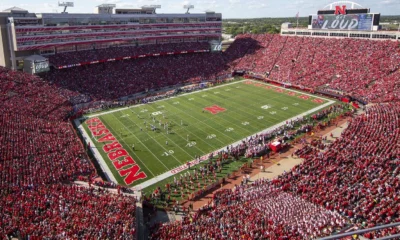

Featured
/ 2 weeks agoFan Guide to the Red-White Spring Game
Nebraska fans are set for a thrilling Saturday at Memorial Stadium for the annual...
-
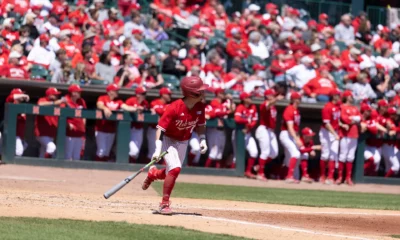

Baseball
/ 2 weeks agoHuskers Command Series Victory with a Resounding Win
In a spectacular show of force, Nebraska equaled its highest run tally of the...
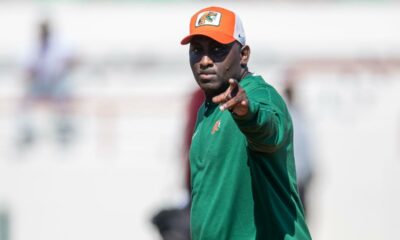

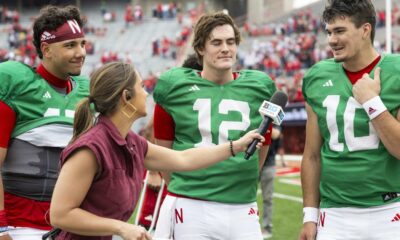



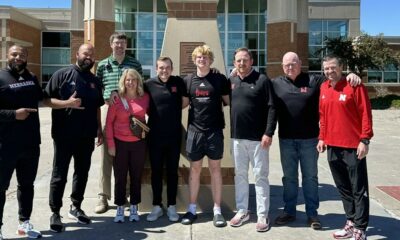







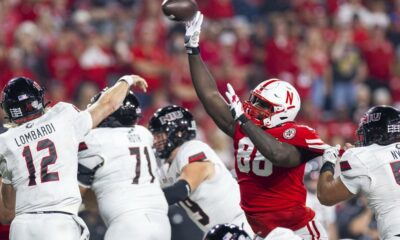

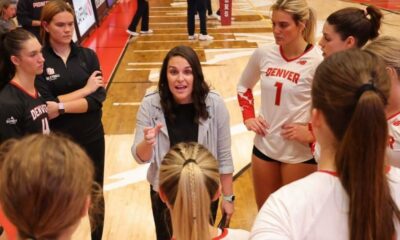





You must be logged in to post a comment Login